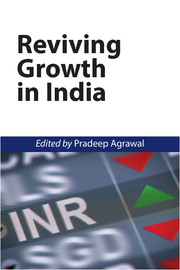Book contents
- Frontmatter
- Contents
- List of Tables and Figures
- Preface
- Section 1 The importance of growth
- Section 2 Reviving growth of industry and exports
- Section 3 The dampeners to growth: Controlling inflation
- Section 4 The supply constraints to growth
- Chapter 8 Sustainability of Indian Agriculture
- Chapter 9 Energy Security for India
- Chapter 10 Social and Physical Infrastructure in India: Constraints to Rapid Growth
- Chapter 11 Infrastructure Challenges in India: The Role of Public–Private Partnerships
- Section 5 Emerging issues in growth: The labour and capital markets
- Contributors
- Index
Chapter 8 - Sustainability of Indian Agriculture
from Section 4 - The supply constraints to growth
Published online by Cambridge University Press: 18 December 2015
- Frontmatter
- Contents
- List of Tables and Figures
- Preface
- Section 1 The importance of growth
- Section 2 Reviving growth of industry and exports
- Section 3 The dampeners to growth: Controlling inflation
- Section 4 The supply constraints to growth
- Chapter 8 Sustainability of Indian Agriculture
- Chapter 9 Energy Security for India
- Chapter 10 Social and Physical Infrastructure in India: Constraints to Rapid Growth
- Chapter 11 Infrastructure Challenges in India: The Role of Public–Private Partnerships
- Section 5 Emerging issues in growth: The labour and capital markets
- Contributors
- Index
Summary
Indian agriculture is now at a critical juncture of history, perhaps comparable only to the time when the celebrated green revolution (GR) was launched. On that occasion, the motive force behind the impending change was the urgent need for food security, and its impetus came from a new production technology and its impact was felt on the wide socio-economic-cultural canvas of the Indian nation. Later, experiences were to show that the production pattern that followed from the circumstances had several serious weaknesses and with time the approach to development proved unsustainable.
Interestingly, today the impetus comes from the momentous transformations in society, culture and economy that India accepted as part of a new paradigm. There is no specific and patently clear motive for the present change except to improve the lot of people especially the farmers. The pressure that ‘food security cannot wait’ is no longer present and India can plan her agriculture much more cautiously than could be done in the earlier instance. All this makes the choice of the path much more flexible but politically and economically more sensitive.
Having learnt many lessons from the past, setting target growth rates and choosing the production paths for achieving them in a sustainable manner appear as a veritable challenge, compounded by the fact that India's domestic economy no longer operates in isolation. Any assessment, methodology, or policy needs to be in tune with the global economic reality. In the face of such confounding decisions, this chapter attempts to reflect rationally on the way forward. This is done by taking the following course: (a) Reviewing and exploring future possibilities for Indian agriculture, (b) identifying the cautions that should guide the path to sustainable growth, and (c) revisiting the observed tendencies in India's production pattern in the perspective of the limitations identified.
The second section reflects on the concept of sustainable growth in agriculture with a futuristic outlook drawing from past experiences, recent events, and international evidences leading to the requisites for sustainable growth listed in third section.
- Type
- Chapter
- Information
- Reviving Growth in India , pp. 197 - 219Publisher: Cambridge University PressPrint publication year: 2015



